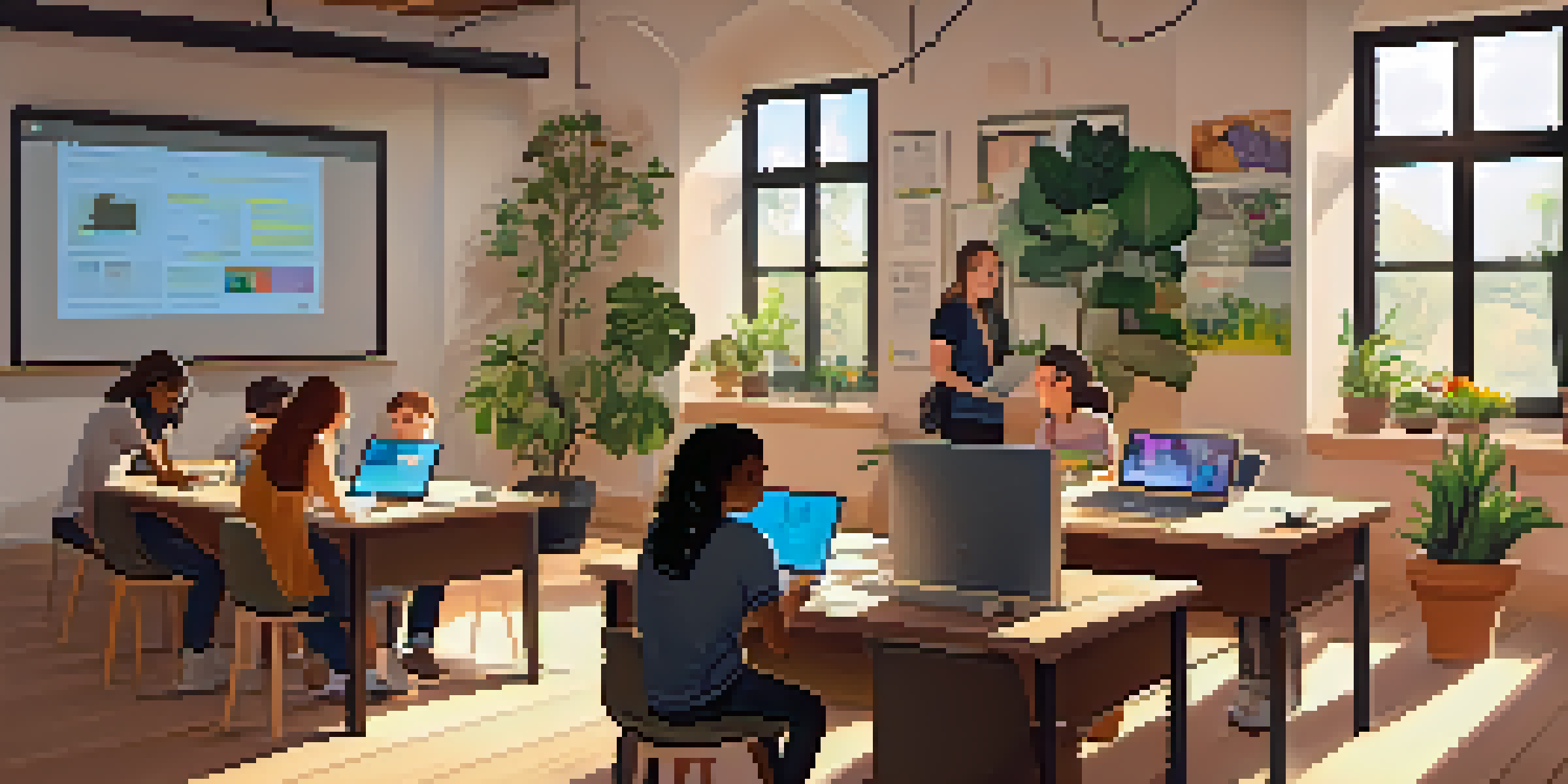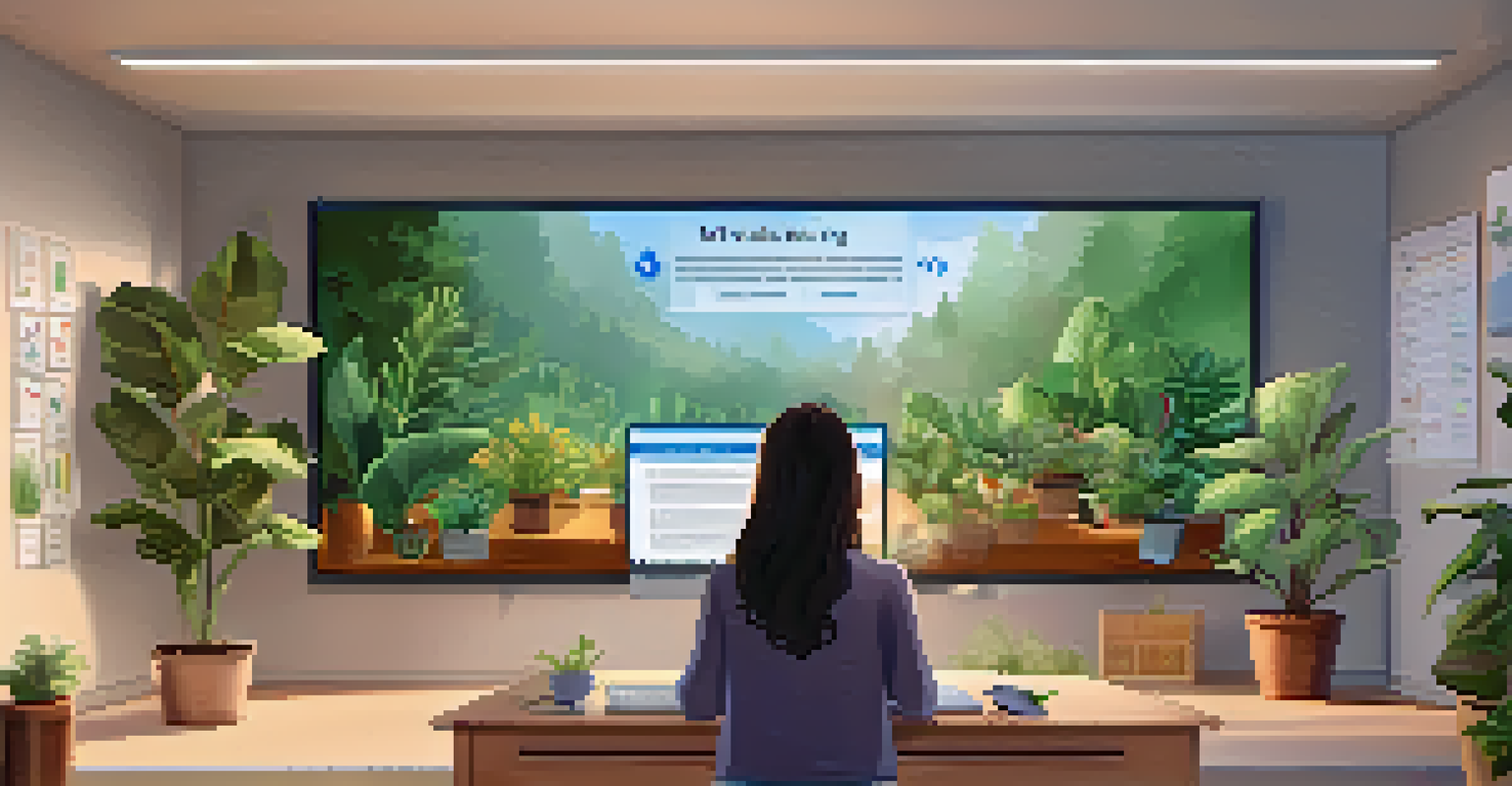Understanding Student Needs in Digital Learning Settings

Recognizing Diverse Learning Styles in Digital Spaces
Every student learns differently, especially in digital settings. Some thrive with visual aids, while others prefer auditory instructions or hands-on activities. Understanding these diverse learning styles is crucial for creating an inclusive online environment. By recognizing these differences, educators can tailor their approaches to better engage all students.
The greatest gift of education is the ability to think critically and creatively, to adapt in a rapidly changing world.
For example, a student who struggles with reading might benefit from video tutorials that explain concepts visually. On the other hand, a student who excels in written communication may prefer detailed articles or discussion forums. This variety not only enhances comprehension but also empowers students to take charge of their learning.
In digital learning, leveraging tools like polls and surveys can help educators gauge students' preferred learning styles. By doing so, they can adjust their teaching methods and resources accordingly, fostering a more effective educational experience for everyone.
The Importance of Personalized Learning Experiences
Personalization is key in digital learning, as it allows students to learn at their own pace. Unlike the one-size-fits-all approach of traditional classrooms, online education can offer tailored paths that meet individual needs. This flexibility is particularly beneficial for students who may need extra time to grasp certain concepts.

For instance, a student struggling with math might benefit from additional practice problems and targeted tutorials. Meanwhile, a student who excels could be offered advanced resources to keep them engaged. By personalizing the learning experience, educators can ensure that each student feels supported and challenged appropriately.
Embrace Diverse Learning Styles
Recognizing and catering to various learning preferences enhances engagement and understanding in digital education.
Using adaptive learning technologies can further enhance personalization. These tools analyze student performance in real-time, adjusting content difficulty and recommendations based on individual progress, ensuring that learning is both effective and enjoyable.
Creating Engaging and Interactive Learning Environments
Engagement is a significant factor in successful digital learning. When students are engaged, they are more likely to participate actively and absorb information effectively. Incorporating interactive elements, such as quizzes, discussion boards, and group projects, can transform a passive learning experience into an engaging one.
Learning is not a spectator sport. Students do not learn much just by sitting in classes listening to teachers, memorizing prepackaged assignments, and spitting back answers.
Consider using gamification techniques, like rewards and badges, to motivate students. These elements tap into students' competitive instincts and can make learning feel less like a chore and more like a fun challenge. For instance, setting up a leaderboard for quiz scores can encourage friendly competition and foster a sense of community.
Moreover, encouraging collaboration through group activities can enhance engagement. When students work together, they not only learn from each other but also build social skills that are essential in both academic and professional settings.
Ensuring Access to Technology and Resources
Access to technology is fundamental for effective digital learning. Unfortunately, not all students have the same access to devices, high-speed internet, or necessary software. This digital divide can create significant barriers to learning, making it crucial for educators to recognize and address these disparities.
Schools and institutions can implement programs to provide devices or subsidize internet costs for underprivileged students. For example, lending libraries for laptops or partnering with local internet service providers can help bridge the gap. By ensuring all students have the tools they need, educators can create a more equitable learning environment.
Personalized Learning is Essential
Tailoring educational experiences allows students to learn at their own pace, ensuring they receive the support they need.
Additionally, offering alternative resources, such as downloadable materials or offline activities, can help students who might struggle with online access. This way, learning continues seamlessly, regardless of technology availability.
Fostering a Supportive Online Community
A strong sense of community is vital in a digital learning environment. When students feel connected and supported, they are more likely to participate and share their ideas. Building this community can be achieved through regular communication, peer interactions, and collaborative projects.
Creating virtual spaces for students to interact, such as forums or social media groups, encourages them to engage with one another. These platforms allow for sharing resources, discussing course material, and building friendships, which can enhance the overall learning experience.
Instructors can play a significant role by actively participating in these communities, responding to questions, and facilitating discussions. By fostering an inclusive atmosphere, educators can help students feel valued and encourage them to express their thoughts and ideas freely.
Gathering Feedback to Improve Digital Learning
Feedback is an essential component of any learning process, and digital environments are no exception. Regularly seeking student input on their experiences can provide valuable insights into what is working and what needs improvement. This information can guide educators in refining course content and teaching methods.
For example, conducting surveys after a module can help identify areas where students struggled or felt disengaged. This feedback allows educators to make real-time adjustments, ensuring that the learning experience remains relevant and effective for all participants.
Build a Supportive Online Community
Fostering a sense of community encourages student interaction and enhances the overall learning experience in digital spaces.
Additionally, creating opportunities for informal feedback, such as open discussions or suggestion boxes, can foster a culture of continuous improvement. When students know their opinions are valued, they are more likely to engage actively in the learning process.
Supporting Mental Health and Well-being in Digital Learning
Mental health is a critical aspect of student success, especially in digital learning settings. The isolation that can accompany online education may exacerbate feelings of anxiety or stress for some students. It's essential for educators to recognize these challenges and provide adequate support.
Incorporating wellness resources, such as counseling services or mindfulness activities, can help students manage stress effectively. For instance, offering virtual workshops on time management or study skills can equip students with tools to navigate their academic responsibilities more comfortably.

Moreover, fostering open communication about mental health can reduce stigma and encourage students to seek help when needed. By prioritizing well-being, educators can create a more supportive and understanding online learning environment, ultimately leading to better academic outcomes.
The Role of Continuous Professional Development for Educators
To meet student needs effectively in digital learning, educators themselves must engage in continuous professional development. As technology and teaching methodologies evolve, staying updated on best practices is crucial. This ongoing learning equips teachers with the skills and knowledge necessary to adapt their approaches.
Participating in workshops, online courses, or professional learning communities can provide educators with fresh perspectives and innovative strategies. For example, learning about new educational technologies can enable teachers to integrate exciting tools into their lessons, enhancing student engagement.
Furthermore, sharing experiences and resources with colleagues fosters a collaborative environment where educators can learn from one another. By investing in their own development, teachers can better serve their students, ensuring that they meet diverse needs in an ever-changing digital landscape.